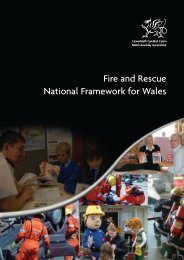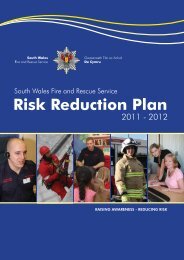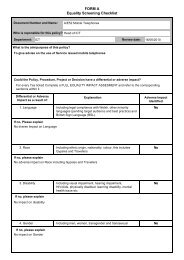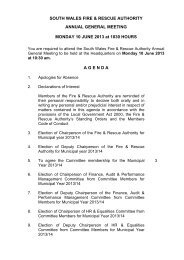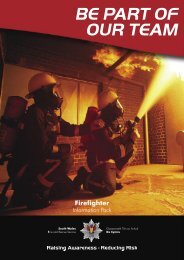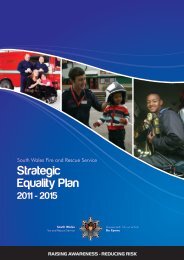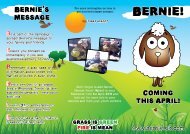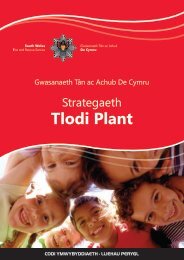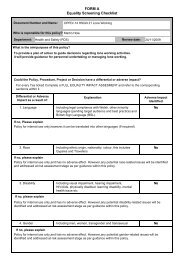Evaluation Phase - South Wales Fire and Rescue Service
Evaluation Phase - South Wales Fire and Rescue Service
Evaluation Phase - South Wales Fire and Rescue Service
You also want an ePaper? Increase the reach of your titles
YUMPU automatically turns print PDFs into web optimized ePapers that Google loves.
Deliberate Grass <strong>Fire</strong>s in Tonyp<strong>and</strong>y <strong>and</strong> Aberdare by month (01/01/2010 - 31/05/2010)<br />
A SOCIAL MARKETING PROJECT<br />
To Reduce The Incidence of<br />
Deliberate Grass <strong>Fire</strong>s<br />
in <strong>Wales</strong>, UK<br />
Summary Report of <strong>Evaluation</strong> <strong>Phase</strong><br />
Prepared by Dr Sue Peattie <strong>and</strong> Dave Ansell
Executive Summary<br />
The following report provides a brief overview of the <strong>Evaluation</strong> <strong>Phase</strong> of Project Bernie - a<br />
social marketing initiative to reduce deliberate grass fires in <strong>Wales</strong>.<br />
This is the fourth report in the series, which follows the Total Process Planning Framework<br />
recommended by the NSMC. It begins with a recap of the recommendations from the<br />
Scoping <strong>Phase</strong> report published in October 2009 <strong>and</strong> then describes the methodology<br />
used for evaluation. The evaluation encompassed both extensive quantitative research <strong>and</strong><br />
qualitative research with key stakeholders including:<br />
• Comparison of deliberate grass fire incidents in Tonyp<strong>and</strong>y relative to Aberdare (control<br />
area) over the six week intervention period (13th March – 26th April 2010) <strong>and</strong> historical<br />
trends;<br />
• Pre <strong>and</strong> post intervention questionnaires (1517 in total) with pupils in Tonyp<strong>and</strong>y <strong>and</strong><br />
Aberdare;<br />
• A debrief ‘speed-dating’ session with 43 members of the SWRFS Community Safety<br />
Partnership (CSP) staff who were involved in the intervention;<br />
• Interviews with six SWFRS Community Safety & Partnership (CSP) managers responsible<br />
for designing <strong>and</strong> delivering the social marketing intervention;<br />
• Interviews with other key Partners – Police, Forestry Commission, Asda, Tonyp<strong>and</strong>y<br />
Community College, Tonyp<strong>and</strong>y community (parents <strong>and</strong> young people) <strong>and</strong> the Youth<br />
Advisory Panel.<br />
This report includes Outcome <strong>and</strong> Process evaluation as well as Cost/Benefit analysis.<br />
Results indicate that Tonyp<strong>and</strong>y had 46% fewer fires during the 6 week period relative<br />
to Aberdare (3 times the original target goal). In addition, the social marketing project<br />
provided a catalyst for a number of improvements in effectiveness <strong>and</strong> efficiency within the<br />
CSP department.<br />
The Partnership working aspect was not as successful as hoped, but Project Bernie now<br />
provides a good framework for improving this in the future.<br />
The report concludes with recommendations for exp<strong>and</strong>ing Project Bernie in the future which<br />
includes better project management <strong>and</strong> better partnership working.<br />
2
Preface<br />
This report provides a short non-technical summary of the <strong>Evaluation</strong> <strong>Phase</strong> for interested<br />
parties. It assumes a basic underst<strong>and</strong>ing of social marketing <strong>and</strong> sight of the Summary<br />
Scoping <strong>Phase</strong> Report (published October 2009), Summary Development <strong>Phase</strong> Report<br />
(February 2010) <strong>and</strong> Summary Implementation <strong>Phase</strong> Report (May 2010).<br />
For the full report for any of the first four stages <strong>and</strong>/or more information about social<br />
marketing, please contact Dave Ansell, Social Marketing Project Manager, <strong>South</strong> <strong>Wales</strong> <strong>Fire</strong><br />
<strong>and</strong> <strong>Rescue</strong> <strong>Service</strong> (d-ansell@southwales-fire.gov.uk). Feedback on this report is welcomed<br />
<strong>and</strong> can be sent to the same address.<br />
Total Process Planning Framework<br />
(NSMC Pocket Guide: Blair-Stevens a French, 2007)<br />
Acknowledgements<br />
We would like to thank all SWFRS CSP staff <strong>and</strong> Project Bernie Partners for participating in<br />
the quantitative <strong>and</strong> qualitative research that has informed this report.<br />
Special thanks are due to Professor Robert Newcombe, Dr Fiona Davies, Professor Robyn<br />
Thomas, Professor Ken Peattie <strong>and</strong> Dr. Diego Vazquez from Cardiff University for providing<br />
their independent <strong>and</strong> specialist expertise on various aspects of the evaluation.<br />
3
Key recommendations from Scoping <strong>Phase</strong><br />
The Scoping report recommended adopting a strategic multi-faceted approach<br />
that harnessed information, education, support, design <strong>and</strong> control components,<br />
to promote positive alternative behaviours <strong>and</strong> limit or remove negative ones.<br />
Overarching Goal (OG):<br />
To reduce the incidence of deliberate grass fires in the Tonyp<strong>and</strong>y area by 15% during the<br />
2-week school Easter period (26th March 2010 – 12th April 2010) in comparison to the<br />
control area of Aberdare (allowing for any variance in weather or other external factors).<br />
Behavioural Goal 1 (BG1):<br />
To promote socially positive alternative behaviours <strong>and</strong> limit or remove opportunities for<br />
negative behaviour that could lead to deliberate causing of fires – with a particular focus on<br />
young people between 13 – 16 years of age (School Year Group 9 – 11).<br />
Behavioural Goal 2 (BG2):<br />
To encourage <strong>and</strong> support key professionals <strong>and</strong> organisations in working together <strong>and</strong><br />
adopting a holistic <strong>and</strong> co-ordinated approach.<br />
4
<strong>Evaluation</strong> <strong>Phase</strong><br />
The social marketing intervention took place over a 6 week period from Saturday March<br />
13th to Sunday April 25th 2010. The main focus was on the school Easter holidays (26<br />
March – 12 April 2010) when a programme of diversionary activities for the young people<br />
of Tonyp<strong>and</strong>y was provided. However, from historical statistical data, the 2 week period pre<br />
<strong>and</strong> post Easter school holidays had also been identified as key times when deliberate grass<br />
fires posed a threat. For this reason, the intervention also included the fortnight before <strong>and</strong><br />
after the two week Easter period. At these times, as well as during the school Easter holidays,<br />
SWFRS fire patrols were in full operation at known hot spot times <strong>and</strong> locations.<br />
The purpose of evaluation is to measure the effectiveness of intervention elements –<br />
individually <strong>and</strong> collectively – based on qualitative <strong>and</strong> quantitative data. A baseline set of<br />
data was established in order to compare actual performance against the planned objectives<br />
of the social marketing intervention. This report includes Outcome <strong>and</strong> Process evaluation<br />
as well as a Cost/Benefit analysis.<br />
Outcome <strong>Evaluation</strong> 1 - this involves assessing the extent to which the stated aims <strong>and</strong><br />
objectives (<strong>and</strong> more specifically the behavioural goals) of the work have been achieved,<br />
drawing on short, medium <strong>and</strong> longer term indicators. As well as considering behaviour<br />
(the extent to which people have changed behaviours, <strong>and</strong> maintained positive changes), it<br />
should consider changes in knowledge (awareness <strong>and</strong> the extent to which information was<br />
understood <strong>and</strong> retained); <strong>and</strong> attitudes (the importance people attach to the issue, in this<br />
case grass fires, <strong>and</strong> the target behaviour).<br />
Overarching Goal (OG):<br />
To reduce the incidence of deliberate grass fires in the Tonyp<strong>and</strong>y area by 15% during the<br />
2-week school Easter period (26th March 2010 – 12th April 2010) in comparison to the<br />
control area of Aberdare (allowing for any variance in weather or other external factors).<br />
Methodology:<br />
Detailed data is available from SWFRS Performance Management Unit recording the number<br />
of deliberate grass fire incidents in Tonyp<strong>and</strong>y during this period. However, it is important<br />
to allow for the strong possibility of large year-to-year differences that are simply due to<br />
weather. Consequently the data analysed incorporates two kinds of control. <strong>Fire</strong>s in the<br />
Tonyp<strong>and</strong>y area were compared to fires in the Aberdare area, in which no such intervention<br />
took place. This is an ideal choice of control area in several respects. The two areas were<br />
both identified as hotspots for deliberate grass fires in preceding years, relative to other<br />
small areas of <strong>Wales</strong>. In each of the 6 preceding years, numbers of fires in the two areas<br />
were similar (though not identical). The numbers of fires fluctuated greatly from year to<br />
year, but retained the same pattern of good <strong>and</strong> bad years. In addition, the two areas are<br />
almost adjacent, separated only by the Rhondda Fach mountain. Thus, there is only a slight<br />
possibility of contamination, i.e. that the benefits of the intervention might spill over into<br />
the control area. The two areas are also of broadly similar topography, so they would be<br />
expected to have similar weather.<br />
1<br />
NSMC Planning Framework 2008<br />
5
verarching Goal:<br />
reduce the incidence of deliberate grass fires in the Tonyp<strong>and</strong>y target area by 15% during the 2 week school Easter<br />
iod (26 March – 12 April 2010) in comparison to the control area of Aberdare (allowing for any variance in weather<br />
other external factors).<br />
Outcome:<br />
havioural goal 1:<br />
socially promote An positive independent alternative analysis behaviour’s of the grass <strong>and</strong> fire limit statistics or remove was opportunities prepared by Robert for negative G. Newcombe behaviour (PhD that could<br />
d to deliberate CStat causing FFPH, of fires Professor - with a of particular Medical focus Statistics on young at Cardiff people University), between applying 13-16 years the of same age rigorous (School Year<br />
oup 9-11). evaluation techniques normally used for epidemiological interventions. His conclusions are:<br />
• For the fortnight that coincides with the Easter break, the best estimate of benefit is a<br />
havioural goal 2:<br />
31% reduction (double the original goal);<br />
encourage <strong>and</strong> support key professionals <strong>and</strong> organisations in working together <strong>and</strong> adopting a holistic <strong>and</strong><br />
rdinated approach.<br />
• However, a more statistically reliable measure would be for the 6 week intervention<br />
period (2 weeks pre, during <strong>and</strong> post Easter). The figures indicate that Tonyp<strong>and</strong>y had<br />
ass fire stats<br />
46% fewer fires during the 6 week period than would be expected on the basis of the<br />
independent report<br />
number<br />
on the<br />
of<br />
grass<br />
fires<br />
fire<br />
in Aberdare<br />
statistics was<br />
in 2010<br />
prepared<br />
<strong>and</strong><br />
by<br />
the<br />
Robert<br />
numbers<br />
G.<br />
of<br />
Newcombe<br />
fires in the two<br />
PhD<br />
areas<br />
CStat<br />
during<br />
FFPH,<br />
the<br />
fessor of Medical<br />
preceding<br />
Statistics.<br />
6 Springs;<br />
His conclusions are:<br />
1% reduction<br />
•<br />
over<br />
For<br />
the<br />
the<br />
Easter<br />
fortnight<br />
period<br />
following<br />
(double<br />
Easter<br />
our target).<br />
when the weather was hot <strong>and</strong> sunny <strong>and</strong> particularly<br />
wever, he has advised<br />
conducive<br />
us that<br />
to<br />
a more<br />
fire-setting,<br />
statistically<br />
the intervention<br />
reliable measure<br />
appears<br />
would<br />
to have<br />
be for<br />
made<br />
the 6<br />
a<br />
week<br />
particularly<br />
intervention<br />
significant<br />
period<br />
weeks pre, during<br />
impact,<br />
<strong>and</strong> post<br />
estimated<br />
Easter) in<br />
as<br />
which<br />
a reduction<br />
case the figure<br />
of 74%.<br />
is 46% (over 3 times our target) <strong>and</strong> for the fortnight<br />
owing Easter that the intervention appears to have made a big impact. We estimate a reduction of 74%”.<br />
s overall the results<br />
Thus the<br />
suggest<br />
overall<br />
that<br />
results<br />
the intervention<br />
shows that<br />
is<br />
the<br />
having<br />
social<br />
a beneficial<br />
marketing<br />
impact<br />
intervention had a beneficial impact.<br />
In addition, it would Deliberate appear Grass from <strong>Fire</strong>s in the Tonyp<strong>and</strong>y following <strong>and</strong> Aberdare graph that by month this (01/01/2010 change in - 31/05/2010) behaviour was<br />
maintained in the short term beyond the intervention period.<br />
Deliberate Grass <strong>Fire</strong>s in Tonyp<strong>and</strong>y <strong>and</strong> Aberdare by month (01/01/2010 - 31/05/2010<br />
No of Incidents<br />
140<br />
135<br />
130<br />
125<br />
120<br />
115<br />
110<br />
105<br />
100<br />
95<br />
90<br />
85<br />
80<br />
75<br />
70<br />
65<br />
60<br />
55<br />
50<br />
45<br />
40<br />
35<br />
30<br />
25<br />
20<br />
15<br />
10<br />
5<br />
0<br />
135<br />
76<br />
73<br />
67<br />
64<br />
17<br />
3 2 10 10<br />
January February March April May<br />
Month<br />
Aberdare<br />
Tonyp<strong>and</strong>y<br />
(NOTE: complete details of the calculations are available in the full <strong>Evaluation</strong> Report)<br />
6
Behavioural Goal 1 (BG1):<br />
To promote socially positive alternative behaviours <strong>and</strong> limit or remove opportunities for<br />
negative behaviour that could lead to deliberate fire setting – with a particular focus on<br />
young people between 13 – 16 years of age (School Year Group 9 – 11).<br />
Methodology:<br />
Baseline data was collected on knowledge, attitudes <strong>and</strong> behaviours of young people in both<br />
Tonyp<strong>and</strong>y <strong>and</strong> Aberdare via questionnaires. These were administered to Year groups 7-11<br />
in Tonyp<strong>and</strong>y Community College, Aberdare Girls School <strong>and</strong> Aberdare Boys School. The<br />
pre-intervention questionnaire was distributed in early March 2010 <strong>and</strong> the post-intervention<br />
survey to measure changes was administered in May 2010.<br />
Outcome:<br />
Number of Respondents to surveys (1517 in total)<br />
Tonyp<strong>and</strong>y<br />
Aberdare<br />
Pre-intervention 244 687<br />
Post-intervention 327 259<br />
Knowledge:<br />
• In both Tonyp<strong>and</strong>y <strong>and</strong> Aberdare there was an increase post-intervention in the percentage<br />
of pupils who though that “most” or “all” grass fires were started deliberately, from 74%<br />
to 84% in Tonyp<strong>and</strong>y <strong>and</strong> from 65% to 77% in Aberdare;<br />
• In both Tonyp<strong>and</strong>y <strong>and</strong> Aberdare there was an increase post-intervention in the percentage<br />
of pupils who gave the correct answer (2) to the number of fire engines in their local fire<br />
station, from 28% to 34% in Tonyp<strong>and</strong>y <strong>and</strong> from 10% to 15% in Aberdare.<br />
This seems to indicate that conducting research into the issue, even without the intervention,<br />
increased young people’s awareness of deliberate grass fires as a social problem.<br />
• In Tonyp<strong>and</strong>y there was better knowledge post intervention on the number of fire fighters<br />
available in each local station. The percentage giving correct answer of 10 increased<br />
from 6% to 11%. However, there was a decrease in correct answers in Aberdare - down<br />
from 11% to 6%;<br />
• There was no change in Tonyp<strong>and</strong>y (20%) pre <strong>and</strong> post intervention, giving the correct<br />
answer of £2000 for the cost of tackling a fire. However, there was a slight decrease from<br />
26% to 24% giving correct answer in Aberdare;<br />
• Only one person in Aberdare post-intervention stated that he had heard of Project Bernie,<br />
but he did not elaborate on the answer.<br />
7
Attitudes <strong>and</strong> Opinions<br />
• Post-intervention, there was significantly more agreement in Tonyp<strong>and</strong>y that “some kids set<br />
grass fires to impress others”. There were no other significant differences in the responses<br />
to the bank of attitude <strong>and</strong> opinion statements. In Aberdare, the only statement where<br />
there was a significant difference was a greater agreement in the second questionnaire<br />
with “The Police should do more to catch the firesetters”;<br />
• 15% of Tonyp<strong>and</strong>y respondents perceived an increase in fires following the intervention.<br />
This was not borne out by the facts;<br />
• In Tonyp<strong>and</strong>y it appears that the intervention increased awareness of the need to take<br />
responsibility for grass fires, as the percentage agreeing that a suggested body or group<br />
should be responsible for reducing grass fires increased by 10% for the <strong>Fire</strong> <strong>Service</strong>, by<br />
4% for young people <strong>and</strong> by 5% for parents. Aberdare showed no increases in these<br />
percentages;<br />
• Although fewer respondents in both areas post-intervention said that grass fires affected<br />
them, there appeared to be a heightened awareness in Tonyp<strong>and</strong>y post-intervention as to<br />
some of the effects of grass fires: the percentage expressing concern for the environment<br />
went up from 8% to 15% (only 8% to 9% in Aberdare); the percentage concerned about<br />
the appearance of the area rose from 9% to 15% (fell in Aberdare); <strong>and</strong> the percentage<br />
concerned about smoke or fumes rose from 4% to 8%, with a slightly smaller 3% rise in<br />
Aberdare;<br />
• The intervention itself appeared to make an impact as 66% of Tonyp<strong>and</strong>y respondents<br />
believed there had been more to do this Easter holiday.<br />
Behaviour<br />
• One in six of the respondents had attended at least one Bernie activity;<br />
• The main reason cited by those who did not attend was that their friends were not going.<br />
(NOTE: Appendix 2 contains a summary of the post-intervention findings from the survey<br />
conducted in Tonyp<strong>and</strong>y Community College. Complete details of all surveys including<br />
copies of the questionnaires are available in the full evaluation report)<br />
Behavioural Goal 2 (BG2):<br />
To encourage <strong>and</strong> support key professionals <strong>and</strong> organisations in working together <strong>and</strong><br />
adopting a holistic <strong>and</strong> co-ordinated approach.<br />
Methodology:<br />
Qualitative interviews <strong>and</strong> focus groups were conducted with personnel from both within<br />
SWFRS <strong>and</strong> from External Partner organisations to evaluate changes in knowledge, attitude<br />
<strong>and</strong> behaviour. These were conducted with:<br />
8
• 6 managers from SWFRS;<br />
• 43 SWFRS CSP department staff;<br />
• Representatives from Partner organisations – Police, Forestry Commission; E3 (Tonyp<strong>and</strong>y<br />
Community College), Asda Tonyp<strong>and</strong>y;<br />
• Tonyp<strong>and</strong>y community (parents & pupils), Youth Advisory Panel.<br />
Outcome:<br />
Internal working within SWFRS<br />
To date, there has often been an acceptance of the annual deliberate grass fires with an<br />
expectation by all departments within SWFRS (e.g. CSP, payroll, stores <strong>and</strong> local fire stations)<br />
that this would be a busy period of the year. Although some educational events continued to<br />
take place in schools, the common view was that there was no other solution to this problem.<br />
In post intervention interviews there was consensus that:<br />
• Project Bernie was quite different to previous projects in being very rigorous, systematic,<br />
evidence led <strong>and</strong> involving the target audience. The average scoping phase for previous<br />
projects had been about 1 month. This compares with the 12 months of research for this<br />
project:<br />
“I think what was really different about this project was that we really got to<br />
unpick the data piece by piece, it was very sequential, it was very honest more<br />
than anything else”;<br />
“In the past there was no sort of involvement in the target group... We’d assumed<br />
alright this will be good, this is shiny, this is pink <strong>and</strong> fluffy. This has got to work<br />
because I have created it .”<br />
• There was a new underst<strong>and</strong>ing that social marketing methodologies can be used<br />
upstream (e.g. funders), downstream (e.g. fire perpetrators) <strong>and</strong> sideways (e.g. partners<br />
or internal staff). In all cases it was necessary to underst<strong>and</strong> the target audience, their<br />
agenda <strong>and</strong> adopt an appropriate intervention mix (educate, control, inform, design,<br />
support). It was acknowledged that all future projects could benefit from the applications<br />
of social marketing principles <strong>and</strong> methodologies;<br />
• The project had been extremely successful in uniting CSP staff who had formerly tended<br />
to work in silos (even bringing together staff that historically had opposing perspectives<br />
on the deliberate grass fire issue):<br />
“It’s certainly gelled the CSP department – the staff. And the buzz it created -<br />
certain barriers <strong>and</strong> personalities were broken down <strong>and</strong> it is a happy ship <strong>and</strong><br />
that’s something that I would like to see continue.”<br />
9
• The project has demonstrated to staff that change can be acceptable <strong>and</strong> that it is<br />
not necessary to stick to a rigid organisational structure. It is often more effective <strong>and</strong><br />
enjoyable to adopt a matrix/project style, with teams working towards one common goal.<br />
It has also shown that sometimes it is worthwhile taking risks <strong>and</strong> being more ambitious<br />
about tackling issues, rather than accepting that some problems are intractable.<br />
Partnership working:<br />
Partnership working has become an extremely important way of working in the public<br />
sector. Many benefits are seen to arise from partnership working <strong>and</strong> other forms of interorganisational<br />
collaboration. In particular, this mode of working is seen to offer: the best<br />
solution in resolving intractable social problems; the most efficient way of utilizing <strong>and</strong><br />
sharing scarce resources <strong>and</strong> institutional knowledge; an effective approach to avoiding<br />
problems of service gaps <strong>and</strong> ensuring seamless service provision; synergistic approaches to<br />
innovation <strong>and</strong> inter-organisational learning; <strong>and</strong> a solution to dem<strong>and</strong>s for greater citizen<br />
democracy <strong>and</strong> inclusive forms of governance.<br />
Research by Hardy, Lawrence <strong>and</strong> Grant (2005) 2 has shown that successful partnership<br />
working is based on cooperative inter-organisational action that produces innovative,<br />
synergistic solutions <strong>and</strong> balances divergent stakeholder concerns. To achieve this, two key<br />
issues need to be at the forefront in the forming <strong>and</strong> maintaining of successful partnerships.<br />
These are:<br />
• achieving a collective identity;<br />
• translating this identity into action through the achievement of common meanings <strong>and</strong><br />
goals.<br />
As noted above, Project Bernie was successful in achieving a stronger internal group identity<br />
within SWFRS CSP. However, this united <strong>and</strong> common identity was not as evident in the<br />
inter-organisational partnerships. The interviews, both within the <strong>Fire</strong> <strong>and</strong> <strong>Rescue</strong> <strong>Service</strong><br />
as well as among other Partners, suggested ambivalence over the success of Bernie in<br />
strengthening <strong>and</strong> developing partnership relations <strong>and</strong> working. A number of interrelated<br />
reasons were attributed to this, which relate back to the Hardy et al. (2005) criteria for<br />
successful partnerships, centering on issues of partnership identity <strong>and</strong> the partnership goals:<br />
“The partnership side was disappointing but it didn’t surprise me. Because I’ve<br />
worked in partnerships before”<br />
Identity<br />
A common challenge in partnership working is creating an identity that reflects the various<br />
partners <strong>and</strong> their organizations. However, Project Bernie is seen primarily as a <strong>Fire</strong> <strong>and</strong><br />
<strong>Rescue</strong> <strong>Service</strong> project with partners making specific contributions, rather than having a<br />
complete <strong>and</strong> separate partnership identity in its own right. Instead there were perceived<br />
to be ‘pockets of partnership working’ within a wider <strong>Fire</strong> <strong>Service</strong> owned project, especially<br />
2<br />
Discourse <strong>and</strong> collaboration: the art of conversation <strong>and</strong> collectivity identity C Hardy, T Lawrence, D Grant - Academy of Management<br />
Review, 2005<br />
10
in relation to some of the activities taking place during the core weeks. However, the <strong>Fire</strong><br />
<strong>and</strong> <strong>Rescue</strong> <strong>Service</strong> are seen to be setting the agenda <strong>and</strong> therefore the establishment of an<br />
identity for Bernie separate from the <strong>Fire</strong> <strong>and</strong> <strong>Rescue</strong> <strong>Service</strong> was difficult to achieve:<br />
“It become a <strong>Fire</strong> <strong>and</strong> <strong>Rescue</strong> <strong>Service</strong> thing”<br />
“Partnership working is the way forward without a shadow of doubt. The ability<br />
to achieve partnership working is the difficult bit. Bernie is about partnership<br />
working but it turned into a <strong>South</strong> <strong>Wales</strong> <strong>Fire</strong> <strong>and</strong> <strong>Rescue</strong> <strong>Service</strong> initiative. And it<br />
shouldn’t have.”<br />
Once Bernie was established as a project <strong>and</strong> a goal, then partners worked effectively<br />
in contributing to the success of the project. However, it is questionable whether this is<br />
partnership working in the pure sense.<br />
Need for common <strong>and</strong> meaningful goals.<br />
Successful partnership working involves achieving common, meaningful goals that reflect<br />
the partnership as well as the integrity of the different partner’s agendas <strong>and</strong> the concerns of<br />
their host organizations. The aims of the partnership, in particular, need to be meaningful for<br />
each of the partners. However, as the project was seen to be owned <strong>and</strong> driven by the <strong>Fire</strong><br />
<strong>and</strong> <strong>Rescue</strong> <strong>Service</strong>, then this would tend to inhibit the achievement of goals that are relevant<br />
<strong>and</strong> resonate with the other partners:<br />
“The key to partnerships is recognizing different agendas <strong>and</strong> common areas.”<br />
“We need to ask what’s going to float their boat?”<br />
“What’s going to be necessary to get these people on board? I think we could<br />
have done that better.”<br />
It is apparent the project would have benefitted from a clearer common identity, separate<br />
to that of SWFRS <strong>and</strong> from involving the key stakeholders/ partners earlier in the project.<br />
This would involve negotiating <strong>and</strong> arriving at common aims <strong>and</strong> underst<strong>and</strong>ings among<br />
the different stakeholders. More efforts are needed at the planning stage to encourage<br />
greater involvement in formulating the aims <strong>and</strong> connecting with the various partner host<br />
organization agendas:<br />
“One of the major pressure points for us was that we started too late – without<br />
a shadow of doubt.” [commenting on when they got people on board with the<br />
project]<br />
11
In addition, more thought should be given to thinking about the needs of partners in terms<br />
of their own accountability, key performance indicators <strong>and</strong> frames of reference.<br />
However, recognition of the importance of partnership working in the delivery of public<br />
services was an issue highlighted by all the interviewees. Furthermore, the effective roll out<br />
<strong>and</strong> replication of Project Bernie in new areas was seen to hinge on the achievement of<br />
effective partnership working.<br />
“We need partnership working if the project is going to be sustainable. Bernie in<br />
the future won’t work without partnership working”<br />
PROCESS EVALUATION - this involves 3 :<br />
• assessing the process <strong>and</strong> capturing learning from the work (at Scoping, Development<br />
<strong>and</strong> Implementation stages);<br />
• considering such factors as efficiency, effectiveness, equity, quality, engagement <strong>and</strong><br />
management processes;<br />
• engagement <strong>and</strong> view of key parties e.g. the team undertaking the work <strong>and</strong> key<br />
stakeholders.<br />
All SWFRS CSP staff were utilized during the 6 week intervention period. Staff took it in<br />
turns to work across teams <strong>and</strong> experience all aspects of the project. This provided a new<br />
opportunity for staff to work with different colleagues to those encountered on a normal<br />
daily basis. Staff liaison <strong>and</strong> regular team meetings took place to develop a coordinated<br />
<strong>and</strong> holistic approach to the project. Comprehensive ‘Team Rota Schedules’ were produced<br />
identifying who was working when <strong>and</strong> where.<br />
Methodolgy:<br />
A Debrief session was held with 34 members of the SWRFS CSP staff who were involved in<br />
the intervention, arranged in two sessions on separate days to give all personnel an equal<br />
opportunity to attend. Those unable to attend were given the opportunity to feedback in<br />
writing. All staff were also invited to feedback anonymously if they preferred. This allowed<br />
every member of the department the opportunity to express their views <strong>and</strong> opinions.<br />
The debrief sessions were arranged into individual topics to cover all aspects of the project.<br />
These were:<br />
• Patrols;<br />
• Promotional Materials (hoodies, key rings, pin badges, window stickers etc);<br />
• Media (newspaper, radio, TV, billboards);<br />
• Diversionary Activities & other potential workshops not offered.;<br />
• Facebook & Website;<br />
• Refreshments & Welfare (personnel <strong>and</strong> delegates);<br />
• Internal Communications & Internal Partners;<br />
• Staffing & Resources;<br />
• External Partners<br />
3<br />
NSMC Toolbox 2010<br />
12
To make the process more engaging <strong>and</strong> enjoyable, the sessions were run along the lines<br />
of ‘speed dating’. For each topic staff worked in a series of small groups to tackle three key<br />
questions:<br />
1) What went well (good bits)?<br />
2) What could have been better (not so good bits)?<br />
3) How do we make this bigger to cover 4 Unitary Authorities (UA’s) in the future?<br />
Each discussion group lasted 10 minutes, was run by an independent <strong>and</strong> impartial facilitator<br />
with the responses collected for subsequent transcription by the secretary responsible to the<br />
area manger for Risk Reduction.<br />
Also included in this analysis is feedback from a focus group with staff at Tonyp<strong>and</strong>y<br />
Community College who were involved in the delivery of Bernie as well as feedback from<br />
the other qualitative interviews with key stakeholders.<br />
Outcome:<br />
This feedback provided extensive <strong>and</strong> comprehensive views on the strengths <strong>and</strong> weaknesses<br />
of this pilot social marketing project <strong>and</strong> what would be required to extend it to other areas<br />
in the future.<br />
Some of the strengths highlighted include:<br />
• The regular <strong>Fire</strong> Patrols around the community demonstrated a new ‘zero tolerance’<br />
approach whilst allowing interaction with the local residents who were happy to see that<br />
some action was being taken to tackle the deliberate grass fire problem:<br />
“All the strategic groups we sit on were aware of the patrols <strong>and</strong> their value. It was<br />
well received by everyone in the community”<br />
• The Bernie logo <strong>and</strong> br<strong>and</strong> became pivotal, gaining lots of attention <strong>and</strong> recognition<br />
throughout the community including neighbouring villages. Everyone could relate to the<br />
Welsh sheep <strong>and</strong> the cartoon character appealed to all ages (it would not have worked<br />
so well with, for example, a fireman icon).The Bernie hoodies, especially the pink ones,<br />
were the most successful promotional article:<br />
“Hoodies were excellent <strong>and</strong> very worthwhile. They gave an image to the project<br />
<strong>and</strong> were worn with pride. The kids soon realised that you had to earn one”<br />
13
• Facebook was an essential <strong>and</strong> successful communication tool allowing two way interaction<br />
with a large number of young people in a personal manner through their preferred media.<br />
It also allowed the young people to view images of their achievements from the events<br />
<strong>and</strong> discuss with friends what they had accomplished:<br />
“Facebook was excellent. All the kids said I was talking to Bernie yesterday. It was<br />
good for putting up the photos of what they have achieved”<br />
• Most of the diversionary activities were well attended <strong>and</strong> successful especially Bush craft,<br />
<strong>Fire</strong> fighter for a day, abseiling <strong>and</strong> the workshops. Many of these activities incorporated<br />
educational elements as well as practical, transferable skills:<br />
“Is there going to be anymore activities going on because I would love to do more<br />
to help stop deliberate grass fires?” (Facebook comment)<br />
“I had loads of fun doing firefighter for the day last week :)” (Facebook comment)<br />
“Jonny <strong>and</strong> Adrian were great. I loved the rat run. I learnt how to work as a team”<br />
(feedback from activity)<br />
“Had a wicked day <strong>and</strong> would definitely apply for a job with the <strong>Fire</strong> <strong>Service</strong>. The<br />
best part was the Search <strong>and</strong> <strong>Rescue</strong>” (feedback from activity)<br />
“They both had a great time <strong>and</strong> didn’t stop talking about the activities. Thank you<br />
all” (parent feedback from activity)<br />
“It was great fun. It shows what people put fire fighters through. Dave <strong>and</strong> Ash<br />
encouraged us” (feedback from activity)<br />
• The Design <strong>and</strong> Print team were extremely helpful <strong>and</strong> produced documents <strong>and</strong> products<br />
of the highest quality;<br />
• Appointing a project manager with no previous social marketing experience (& therefore<br />
no pre-conceived ideas) but who had top management backing was effective as was<br />
using external experts in social marketing <strong>and</strong> project management to add rigour;<br />
• Project Bernie adopted a Strategic Social Marketing mix with 5 key delivery teams (inform,<br />
control, design, educate, service / support). It has been evident that no one delivery team<br />
would have succeeded on its own but success was due to them all addressing the issue in<br />
a holistic way.<br />
14
Some of the weaknesses highlighted included:<br />
• Confusion over the protocol <strong>and</strong> procedure for reporting incidents to <strong>South</strong> <strong>Wales</strong> Police<br />
(SWP) <strong>and</strong> SWFRS <strong>Fire</strong> Control;<br />
• Some flaws in the activity booking system, logistics, equipment, facilities <strong>and</strong> distribution<br />
of the hoodies;<br />
• Insufficient opportunity for the Tonyp<strong>and</strong>y fire station crew <strong>and</strong> SWFRS staff from other<br />
departments to be involved;<br />
• Differing levels of involvement of external Partners;<br />
• Overburdening of some staff with responsibilities e.g. Facebook, project management ,<br />
some of the diversionary activities & fire patrols;<br />
• Limited internal communications (to get internal buy in) <strong>and</strong> external communications to<br />
Partners;<br />
• Inadequate time management <strong>and</strong> lack of resources.<br />
Cost Benefit Analysis <strong>and</strong> Return on Investment<br />
This analysis looks at the range of costs <strong>and</strong> benefits associated with the BERNIE project. In<br />
theory, if benefits exceed costs such an intervention would be justified on economic grounds.<br />
Economic costs <strong>and</strong> benefits have been accounted for as fully as possible. However, a<br />
proviso is necessary - the analysis does not attempt to monetise all costs <strong>and</strong> benefits. This<br />
is particularly important in terms of policy implications, since non economic benefits are<br />
expected to be significant while non economic costs are negligible. Specifically, a monetary<br />
value associated with the potential damage caused by deliberate grass fires (e.g. to forestry)<br />
is not calculated. In addition, environmental benefits (e.g. carbon emission reductions <strong>and</strong><br />
protection of biodiversity in the area) <strong>and</strong> social benefits have not been included in the<br />
calculations. For example, <strong>South</strong> <strong>Wales</strong> Police statistics for the period (see Appendix 4)<br />
indicate a significant reduction in other forms of anti-social behaviour.<br />
The Return on Investment (ROI) evaluates the efficiency of the investment <strong>and</strong> allows<br />
comparison with alternative investments. The return on investment formula is:<br />
ROI =<br />
(Gain from Investment - Cost of Investment<br />
Cost of Investment<br />
If the ROI is negative, the project is not economically viable <strong>and</strong> it should have not been<br />
undertaken (French et al, 2009).<br />
15
The results in Appendix 3 show that from 2010 net costs are lower than benefits (savings<br />
achieved) leading to a positive ROI as early as the first year of the intervention. This suggests<br />
that even if the project were discontinued, Project Bernie has been successful on economic<br />
grounds; reached break-even point <strong>and</strong> provided value for money. However, if the project is<br />
continued, the ROI will have doubled in just 2 years <strong>and</strong> it will keep providing increasingly<br />
above average returns.<br />
Conclusions<br />
Overall Project Bernie has delivered beyond everyone’s expectations. In addition to reducing<br />
the number of deliberate grass fires, there appears to have been a change in the awareness<br />
<strong>and</strong> attitude of the community to the issue:<br />
“People are far more aware of the issue <strong>and</strong> perception of the incidents. It has<br />
changed the views of ‘it’s normal, let’s except it’ to ‘let’s do something about it.’<br />
The social marketing approach has developed a more holistic <strong>and</strong> harmonious internal<br />
work force within the CSP department, with personnel developing a greater underst<strong>and</strong>ing<br />
<strong>and</strong> appreciation of each others’ differing roles. There is great interest <strong>and</strong> enthusiasm from<br />
other SWFRS staff to be involved in future initiatives.<br />
Although the partnership aspect of the project was less successful, SWFRS can now go to the<br />
table with a solution rather than a concept. Project Bernie can in many cases offer something<br />
tangible which also meets the agenda of other organisations. There is a genuine willingness<br />
from all stakeholders to improve partnership working on this issue in the future:<br />
“…..looking back on it, we could have done more. It was a very good start but<br />
next year the experience will be bigger <strong>and</strong> better <strong>and</strong> more powerful.”<br />
(quote from Partner)<br />
Recommendations<br />
Recommendations for extending Project Bernie fall into two main categories:<br />
Better project management including:<br />
• Appointing a dedicated co-ordinator or team of people depending on the size of the<br />
proposed area to be covered;<br />
• Being aware that to maintain the behaviour in Tonyp<strong>and</strong>y, the intervention approach will<br />
need to be continuously rejuvenated <strong>and</strong> maintained;<br />
• Appreciating that any new target areas may be different to Tonyp<strong>and</strong>y <strong>and</strong> therefore there<br />
is a need to listen, learn <strong>and</strong> adapt the approach to the target audience;<br />
• Earlier planning <strong>and</strong> tighter control on all aspects of the intervention (e.g. number <strong>and</strong><br />
contents of activities offered, resources, booking system for activities, staffing, training of<br />
personnel, budgets, communications);<br />
• Drawing up guidelines in collaboration with SWFRS Print <strong>and</strong> Media team on the protocol<br />
for using the Bernie br<strong>and</strong> in order to maintain its integrity.<br />
16
Better partnership working.<br />
Expansion cannot be achieved by SWFRS working in isolation but will need support <strong>and</strong><br />
development from high level strategic managers, Unitary Authority CSP’s, <strong>South</strong> <strong>Wales</strong> Police,<br />
Local Education, Forestry Commission <strong>Wales</strong> <strong>and</strong> other partnership working. Deliberate<br />
grass fires are now seen as an issue that affects ALL partners. In order to develop stronger<br />
partnerships it is recommended that:<br />
• Partnerships are organised at a strategic level in the form of a service level agreement<br />
but with co-operation at strategic <strong>and</strong> tactical levels. Many good partnerships are built on<br />
personal relationships therefore it would be particularly advantageous if the continuity of<br />
partner representatives could be maintained (even if their own internal job role changes);<br />
• Use the existing partnerships (e.g. E3 programmes, Asda) which may also available in<br />
other areas to be targeted;<br />
• Liaise <strong>and</strong> obtain support for resources <strong>and</strong> assistance from other community groups <strong>and</strong><br />
the private sector;<br />
• Involve all partners at an earlier stage <strong>and</strong> keep them fully engaged throughout.<br />
17
Appendix1: Some facts <strong>and</strong> figures on the<br />
Strategic Social Marketing Mix<br />
Strategic Social Marketing Mix<br />
Inform<br />
Educate<br />
Support<br />
Design<br />
Control<br />
Influencing behaviour - 5 primary domains<br />
(NSMC Pocketbook: Blair-Stevens & French, 2009)<br />
Project Bernie adopted a Strategic Social Marketing mix with 5 key delivery groups (Inform,<br />
Control, Design, Educate, <strong>Service</strong> / support).<br />
INFORM<br />
• Facebook went live on 24th February becoming popular <strong>and</strong> successful very quickly with<br />
161 friends joining in the first 7 days. On Monday 15 March, 2 days after the first high<br />
visibility patrol, 95 people joined in 24 hours. A total 1022 people became friends of<br />
Bernie overall. On average Bernie was chatting live to 15 young people a night mostly<br />
between 20:00 <strong>and</strong> 22:00.<br />
• From the 21 Feb 2010 to the 25th May 2010 the English website had 1867 hits <strong>and</strong> the<br />
Welsh version 51 hits.<br />
• Project information was sent to over 40 national <strong>and</strong> international contacts<br />
• For 12 days out of the 16, SWFRS staff had a presence in Asda, speaking to the public<br />
regarding Bernie.<br />
• 5 meetings were held with the Youth Advisory panel (5 boys <strong>and</strong> 2 girls) to obtain feedback<br />
on Bernie br<strong>and</strong>ing; Facebook & website including the content <strong>and</strong> style; promotional<br />
material; post intervention analysis.<br />
18
CONTROL<br />
• 121 Patrols were carried out over a 6 week period. Each patrol had 2 occupants <strong>and</strong><br />
averaged a 7 hour period. This equates to 1694 staff hours <strong>and</strong> use of 121 vehicles.<br />
• 5 young people were arrested with 1 prosecution for setting deliberate grass fires.<br />
• 30 local businesses pledged their support to a voluntary scheme concerning the sale of<br />
matches <strong>and</strong> lighters to persons less than 18 years of age.<br />
EDUCATE<br />
• In order to continue educating children on the consequences of deliberate grass fires for<br />
people, property <strong>and</strong> their environment , 2 members of SWFRS staff underwent training to<br />
deliver the Forest Schools education program. So far, three groups of 13 year olds have<br />
received a one day forest schools session <strong>and</strong> a local primary school is due to start in the<br />
autumn term.<br />
• 15 drama students from Year 10 Tonyp<strong>and</strong>y Community College researched <strong>and</strong><br />
produced a DVD on deliberate grass fires. Their research included attending a <strong>Fire</strong> <strong>Service</strong><br />
presentation, visiting a <strong>Fire</strong> Station <strong>and</strong> gathering views from the community <strong>and</strong> fellow<br />
students. The film includes short interviews portraying representatives of the community<br />
including youths, parents <strong>and</strong> elderly persons. It is planned that the DVD will be seen by<br />
local primary schools <strong>and</strong> youth voluntary organizations during the next year.<br />
• 24 educational events were delivered to a total of 710 pupils from Year groups 8,9 & 10<br />
at Tonyp<strong>and</strong>y Community College<br />
DESIGN<br />
• An agreement was made between the Probation <strong>Service</strong> <strong>and</strong> the Forestry Commission<br />
that they would use people on Community <strong>Service</strong> to clear areas of bracken near to the<br />
forestry. This operation was conducted on 1 occasion<br />
SUPPORT<br />
• The activity events had provision for a total of 360 places. Of these there were 312<br />
attendees with an even 50 - 50 split of female <strong>and</strong> male. Each received a certificate<br />
of attendance incorporating the Pledge conceived by the Youth Advisory Panel “I am<br />
helping <strong>and</strong> supporting Bernie in reducing deliberate grass fire across<br />
<strong>Wales</strong>”.<br />
• From the initial order of 750 hoodies there are 7 pink <strong>and</strong> 63 black remaining<br />
19
Appendix 2 - Summary of post-intervention<br />
findings (Tonyp<strong>and</strong>y)<br />
Questionnaires returned<br />
Yr 7 Yr 8 Yr 9 Yr 10 Yr 11 Total<br />
Male 43 49 26 15 21 154<br />
Female 47 41 38 17 28 171<br />
Total 90 90 64 32 49 325<br />
Plus 2 more who omitted to answer whether male or female.<br />
Response to activities<br />
201 respondents 66% (86 boys, 115 girls) said there had been more to do in the Easter<br />
holidays.<br />
272 did not attend any Project Bernie activities; 55 attended one or more activities.<br />
Reasons for not attending:<br />
150<br />
120<br />
90<br />
60<br />
30<br />
0<br />
Activities did not appeal<br />
74 (27% non-attenders)<br />
Day/time inconvenient<br />
53 (20%)<br />
Session fully booked<br />
28 (10%)<br />
Friends not going<br />
121 (45%)<br />
Other reasons*<br />
70 (26%)<br />
*Most frequently mentioned were “on holiday” <strong>and</strong> “did not want to go”<br />
20
Mean ratings of activities (1 to 6 scale, 6 is highest rating)<br />
Number attending<br />
Mean rating<br />
Graffiti Art 42 4.05<br />
Bushcraft Survival Skills 41 3.59<br />
<strong>Fire</strong>fighter for a day 57 4.40<br />
Pottery Workshop 35 3.94<br />
Abseiling 39 3.85<br />
Music Workshop - record your own CD 35 4.29<br />
Other things they did in holidays:<br />
300<br />
250<br />
200<br />
150<br />
100<br />
50<br />
0<br />
Went out with friends - 266 (81%)<br />
Away from Rhondda - 99 (30%)<br />
At home/with family - 164 (50%)<br />
Indoor activities (e.g. computer, TV) - 153 (47%)<br />
Indoor sports - 54 (17%)<br />
Went shopping - 164 (50%)<br />
Outdoor activities - 123 (38%)<br />
Other activities - 16 (5%)<br />
21
Opinions on Project Bernie:<br />
16 (5%)<br />
136 (42%)<br />
11 boys, 5 girls<br />
Positive comment<br />
No comment<br />
Negative comment<br />
175 (53%)<br />
65% of girls, 41% boys<br />
Apart from Year 10 where only 7 of the 32 respondents commented positively, over 50% of<br />
each year group were positive about Project Bernie.<br />
However 49 respondents (most of whom were positive about Bernie generally) perceived<br />
there had been more fires since the project started.<br />
Best ways to keep people informed about Project Bernie:<br />
Bernie Facebook 176 (54%)<br />
Bernie Website 81 (25%)<br />
Posters in school 158 (48%)<br />
School assembly 144 (44%)<br />
Other ways 20 (6%)<br />
0 50 100 150 200<br />
22
Questions on grass fires<br />
212 respondents (69%) believed most grass fires to be started deliberately, while 44 (14%)<br />
believed all were started deliberately.<br />
The most popular answer to the number of fire engines in the area <strong>Fire</strong> Station was 2, chosen<br />
by 105 respondents (32%). The correct answer is 2.<br />
There was a variety of answers to how many firefighters were on duty, each of the possible<br />
answers being chosen by at least 17 people. The most popular answer was 8 (52 people,<br />
17% of sample). The correct answer is 10.<br />
Few people chose the £50 <strong>and</strong> £100 alternatives for the cost to tackle a grass fire, but<br />
responses were similar for the other categories. The correct answer is £2000.<br />
80<br />
70<br />
60<br />
50<br />
40<br />
30<br />
20<br />
10<br />
0<br />
£1000 - 78 (24%)<br />
£2000 - 61 (19%)<br />
£5000 - 66 (20%)<br />
£10,000 - 80 (25%)<br />
23
Whose responsibility to reduce grass fires?<br />
200<br />
194 (59%)<br />
151 (46%)<br />
150<br />
117 (36%)<br />
102 (31%)<br />
100<br />
79 (24%)<br />
50<br />
<strong>Fire</strong> <strong>Service</strong><br />
Police<br />
Young People<br />
Forestry Commission<br />
Parents<br />
Comparisons of mean responses to the statements about grass fires, pre <strong>and</strong> post-intervention:<br />
The only statement where there was a significant difference between pre- <strong>and</strong> post-intervention<br />
means was “Some kids set grass fires to impress others”. Mean went up from 3.14 to 3.29<br />
(sig t = 0.02) where 3 was “agree” <strong>and</strong> 4 was “strongly agree”.<br />
How grass fires affect respondents:<br />
Post intervention, the most noticeable changes in responses to this question were the number<br />
of respondents mentioning the effects on the environment (up from 8% to 15%), the look of<br />
the area (up from 9% to 15%), <strong>and</strong> the fumes <strong>and</strong>/or smell (up from 4% to 8%).<br />
24
Appendix 3<br />
Table 1: Distribution of Incurred (2009/2010)<br />
<strong>and</strong> expected (2011-2020) costs <strong>and</strong> savings/benefits<br />
Year<br />
Cost of<br />
Consultants<br />
Annual Cost<br />
Overtime Marketing Manager Total<br />
Benefits<br />
Cost <strong>Fire</strong><br />
Avoided<br />
Net Flow<br />
2009 10,218 32,827 43,045 -43,045<br />
2010 46,742 27,500 16,500 32,827 123,569 285,655 162,086<br />
2011 5,000 16,500 32,827 54,327 285,655 231,328<br />
2012 5,000 16,500 32,827 54,327 285,655 231,328<br />
2013 5,000 16,500 32,827 54,327 285,655 231,328<br />
2014 5,000 16,500 32,827 54,327 285,655 231,328<br />
2015 5,000 16,500 32,827 54,327 285,655 231,328<br />
2016 5,000 16,500 32,827 54,327 285,655 231,328<br />
2017 5,000 16,500 32,827 54,327 285,655 231,328<br />
2018 5,000 16,500 32,827 54,327 285,655 231,328<br />
2019 5,000 16,500 32,827 54,327 285,655 231,328<br />
2020 5,000 16,500 32,827 54,327 285,655 231,328<br />
Total 709,884 3,142,209 2,432,325<br />
In Table 1, costs <strong>and</strong> benefits are matched to calendar years. However, benefits only reflect<br />
savings from fires prevented in the 4 month period from February to May every year. This<br />
covers the 2 week pre, post <strong>and</strong> Easter school holiday period irrespective of when Easter falls<br />
each year. If behaviour is maintained <strong>and</strong> there is a reduction in fires at other times of the<br />
year, then benefits will be even greater.<br />
Costs for overtime (primarily to finance <strong>Fire</strong> Patrols) are estimated to fall significantly in<br />
subsequent years as most of this work would be conducted by or with <strong>South</strong> <strong>Wales</strong> Police.<br />
The distribution of BERNIE project costs <strong>and</strong> benefits in Table 1 shows that savings (benefits)<br />
commence in 2010, but costs had been incurred already in 2009. Therefore, a key element<br />
of the cost-benefit analysis framework is the use of a discount rate to compare costs <strong>and</strong><br />
benefits received at different points in time.<br />
Although the choice of discount rate can make a significant difference to whether the present<br />
value of a project is positive, there is debate about the appropriate discount rate, with costbenefit<br />
guides, academics <strong>and</strong> textbooks giving conflicting advice. A high discount rate<br />
favours projects where benefits are accrued early while a low discount rate favours projects<br />
where significant costs are incurred before benefits are obtained. The timeframe selected<br />
for the project will also influence the impact of discount rates. High discount rates will be<br />
particularly disfavour short projects where cost are incurred early <strong>and</strong> benefits perceived late<br />
(as in the case of BERNIE if we consider it a two year project)<br />
25
The discount rate used to evaluate the present value of future costs/benefits takes into<br />
account interest rates <strong>and</strong> inflationary effects. The most commonly used discount rate in<br />
the cost benefit analysis of public projects in UK is 3.5% as recommended by the “Treasury<br />
Green Book”, which can be accessed via the Treasury website (www.hmtreasury.gov.uk). The<br />
3.5% figure for the discount rate assumes a growth rate of 2%, <strong>and</strong> a pure time preference<br />
rate of 1.5%.<br />
The higher the discount rate,the more conservative the model in terms of present net benefits<br />
obtained. 7 % is appropriate when expected future benefits have a wide span of confidence<br />
levels ( Littlechild, 1981). It is also appropriate when project flows are sensitive to market<br />
returns <strong>and</strong> other factors, while projects that are less sensitive (as in our case) should have<br />
a lower one. The low- risk characteristics of the proposal (e.g, clearly defined fixed costs<br />
<strong>and</strong> low expected variation of costs <strong>and</strong> benefits with the state of the economy) suggest that<br />
3.5% discount rate is the most appropriate value for this project. However, following Davies<br />
(1991) we verify sensibility of cost/benefits to discount-rate selection with a higher discount<br />
rate (7%) Therefore two Models are assessed using different discount rates. While Model 1<br />
uses a discount rate of 3.5%, Model 2 uses a discount rate of 7%.<br />
Table 2: Cost-Benefits Analysis<br />
Year<br />
2009<br />
Model 1<br />
Discount rate: 3.5%<br />
Model 2<br />
Discount rate: 7%<br />
ROI Net Benefit ROI Net Benefit<br />
2010 0.8 109,720 0.8 101,344<br />
2011 1.6 318,365 1.7 290,176<br />
2012 2.2 519,954 2.2 466,656<br />
2013 2.5 714,727 2.5 631,590<br />
2014 2.8 902,912 2.8 785,734<br />
2015 2.9 1,084,734 3.0 929,793<br />
2016 3.1 1,260,408 3.1 1,064,429<br />
2017 3.2 1,430,141 3.2 1,190,256<br />
2018 3.3 1,594,134 3.3 1,307,851<br />
2019 3.4 1,752,581 3.4 1,417,754<br />
2020 3.4 1,905,670 3.4 1,520,467<br />
Model 1 ROI = 3.4 PVC = 578,717 PVB = 2,571,342 Net Benefit = 1,905,670<br />
Model 2 ROI = 3.4 PVC = 481,437 PVB = 2,142,037 Net Benefit = 1,520,467<br />
1<br />
Sensitivity analysis informs how changes in figures assigned to different variables will affect the overall costs <strong>and</strong> gains of the project. It<br />
shows how sensitive predicted net benefits are to different values of uncertain variables <strong>and</strong> to changes in<br />
Assumptions ( Davies, 1991)<br />
26
The results in Table 2 show that from 2010 net costs are lower than benefits (savings achieved)<br />
leading to a positive ROI as early as the first year of the intervention suggesting that even<br />
if the project were discontinued, Project Bernie has been successful on economic grounds;<br />
reached break-even point <strong>and</strong> provided value for money.<br />
Additionally, the long term implications for sustaining the policy should be assessed (French<br />
et al, 2009). The increase in positive net flow from 2010 shown in Model 1 <strong>and</strong> Model 2<br />
indicates that the longer the project is sustained, the higher the returns that will be obtained.<br />
When present values of future cost <strong>and</strong> benefits are accounted for <strong>and</strong> ROI assessed against<br />
a project time-frame ranging from 2010 to 2020, the analysis reveals than if the project<br />
is carried on just two more years (until 2012) the gains of the project (in terms of present<br />
value of savings achieved) will have doubled the investment, regardless of the discount<br />
rate adopted. The sensitivity analysis also shows that predicted net benefits <strong>and</strong> ROI do<br />
not change substantially with different values of discount rate <strong>and</strong> therefore there is low<br />
sensitivity to changes in discount rate assumptions.<br />
All in all, the cost-benefits analysis indicates that the investment was a viable option <strong>and</strong> if<br />
the project is continued it will keep providing increasingly above average returns.<br />
References<br />
Davies, H (1991) Managerial Economics for business, management <strong>and</strong> accounting,<br />
London: Pittman<br />
French, J, Blair-Stevens, C, McVey, D <strong>and</strong> Merrit, R (2009). Social marketing <strong>and</strong> public<br />
health theory <strong>and</strong> practice, p133<br />
Littlechild, S ( 1981) ‘Misleading calculations of the social costs of Monopoly power’,<br />
Economic Journal, 86, pp 321-342<br />
27
Appendix 4 - <strong>South</strong> <strong>Wales</strong> Police Statistics on<br />
other reported anti-social<br />
behaviour<br />
Project Bernie had an overarching goal of reducing deliberate grass fires in Tonyp<strong>and</strong>y<br />
however it appears to have produced additional benefits of reducing reported crime in the<br />
same area over the same period.<br />
The <strong>South</strong> <strong>Wales</strong> Police statistics are worked out on an electoral ward basis. In the Tonyp<strong>and</strong>y<br />
area there are 4 electoral wards; Llwynypia, Tonyp<strong>and</strong>y, Penygraig <strong>and</strong> Clydach Vale. The<br />
reported crime figures for the 3 months of April, May <strong>and</strong> June were 369 in 2008 <strong>and</strong> 346<br />
in 2009. The implementation of Bernie has seen these three months figures reduce to 262<br />
in 2010, a reduction of nearly 25% compared to 2009.<br />
In the ward of Penygraig there was an impressive 61% decrease in reported crime for the<br />
month of May compared to the 2008 figure.<br />
Reported anti-social behaviour for Tonyp<strong>and</strong>y 2008-10 Source: SW Police<br />
180<br />
Overall (4 beats 1507/1505/1506/1509)<br />
160<br />
140<br />
120<br />
100<br />
80<br />
60<br />
40<br />
20<br />
0<br />
January February March April May June<br />
2008 2009 2010<br />
Obviously for complete analysis we would need corresponding statistics for Aberdare as a<br />
control group. Unfortunately these were unavailable at the time of publication.<br />
28



